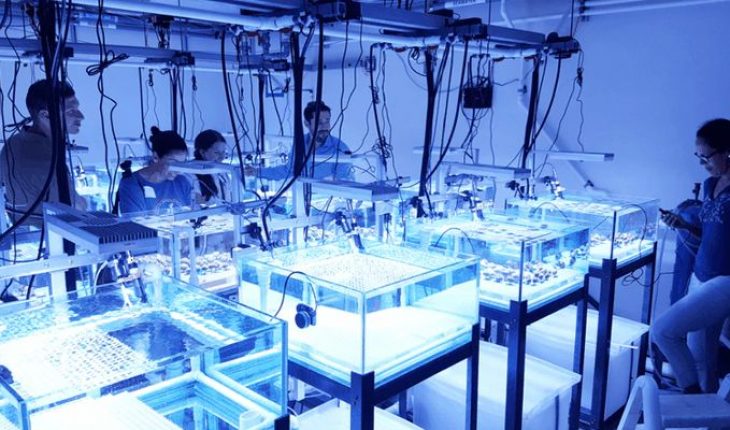Mexico. – For the first time in Mexico, scientists from the Regional Center for Fisheries Aquaculture Research (CRIAP) in Puerto Morelos, Quintana Roo, managed to sexually reproduce coral colonies within their growing systems, a feat that represents a hope for the preservation of the Mesoamerican Reef, one of the most important marine ecosystems in the world.
The project to rescue emblematic coral species, led by researcher Claudia Padilla Souza, seeks to preserve species that are at risk of local extinction and whose sexual reproduction in their natural environment is practically impossible.
Corals are colonial animals of ecological importance. They are the main reef trainers, home to thousands of marine species and a barrier of coastal projection to meteorological phenomena, says Claudia Padilla a Aristegui Noticias.
A coral colony is a calcium carbonate rock structure (skeleton) covered by hundreds or thousands of small organisms called polyps that make up living tissue. Within these polyps live in symbiosis microalgae called zooxanthing, which give color to the coral.
Sexual reproduction is the natural fertilization process that corals have to multiply, like every animal species. Corals breed one or several times a year, depending on the type of coral, and at certain times and days, depending on the sunset or the position of the moon, explained the specialist.
In the process without human intervention, each coral colony releases eggs called “gametes”. These gametes are a millimeter sac that contains eggs and sperm, which break and are released into the water. Sperm from one colony are joined with eggs from another coral colony of the same species and fertilization is achieved.
From this fertilization “born” a coral larva that will seek to look to be fixed in a small solid structure that will then be transformed into a first polyp to start a new coral colony, which will grow over the years.
For the fertilization process to occur, coral colonies must be close to each other, so that sperm from one colony mix with the eggs of another, and vice versa.
However, over the past four decades the reef barrier off the coast of the Mexican Caribbean has lost more than 80 percent of its coral coverage, coinciding with the real estate boom in the region since the 1970s, says Lorenzo Alvarez Filip of the Arrecifal Biodiversity and Conservation Laboratory.
But the shot of grace began in May 2018, when researchers first detected the outbreak of White Syndrome in the region’s corals, a disease capable of killing colonies that took hundreds of years to form in a matter of weeks.
This disease brought at least four species to the limit of local extinction, a situation that made it impossible to reproduce and natural repopulation.
Faced with this situation, the team of researchers from CRIAP, in Inapesca, in collaboration with the organization Healthy Reefs and UNAM, recreated the sea conditions in a controlled pond to reproduce four colonies of the species Diploria Labyrinthiformis, better known as “brain coral”. On July 16, as the afternoon began to fall, biologists Eloy Ramírez and Andrés Morales prepared to monitor the colonies inside the pond, on the last day with possibilities for spawning, according to the breeding cycle. The same had been done the previous four days without success.
Their faces were underre hopeful, although they talked of having a positive attitude to make it happen.
“The experience of watching spawning is fantastic, waiting and starting to come out, it almost never happens, but when it happens it’s spectacular,” Andrés Morales said.
Shortly before 6 p.m., Eloy Ramirez entered the pond and began preparing the equipment. In each coral was placed a kind of cone-shaped veil with the tip facing upwards, held from the bottom by some pieces of lead. At the top was placed a container, as far as the gametes would rise if spawning was achieved. At approximately 18:15 hours the first eggs of the only colony discovered began to come out, so they could not be captured, but this mobilized the biologists, as it was a sign that a second litter of that same colony and most likely of the other three was coming.
No more than 10 minutes passed when, at the same time, three of the colonies began to shed their eggs, which inside contained sperm and eggs.
At the end of the process, the containers with the eggs were taken to the lab and mixed those of a colony with another, to achieve fertilization. From this procedure were born about 500 thousand larvae that same night, which after some days of maturation were deposited in another pond where there are small concrete structures called “substrates”, Claudia Padilla indicated in interview.
These larvae were fixed to these small structures of half a centimeter in diameter and, after a few days, were transformed into the first coral polyps, which over time will multiply and form new coral colonies, with which it is intended to repopulate the reefs.
This coral assisted reproduction technique had been successfully performed in Australia and Florida, USA, but this is the first time it has been achieved in Mexico, with the support of the international organization Mar Foundation.
María del Carmen García Rivas, director of the Arrecifes National Park of Puerto Morelos, explains that the life and economy of the entire Mexican Caribbean depend on the reefs. Coral reefs provide the white sand and turquoise hue of the sea that year after year attracts more than 15 million tourists, as well as being a barrier of protection for coastal infrastructure and the home of hundreds of species of commercial interest.
translated from Spanish: Mexico first achieves sexual reproduction of corals in laboratory
July 26, 2020 |





